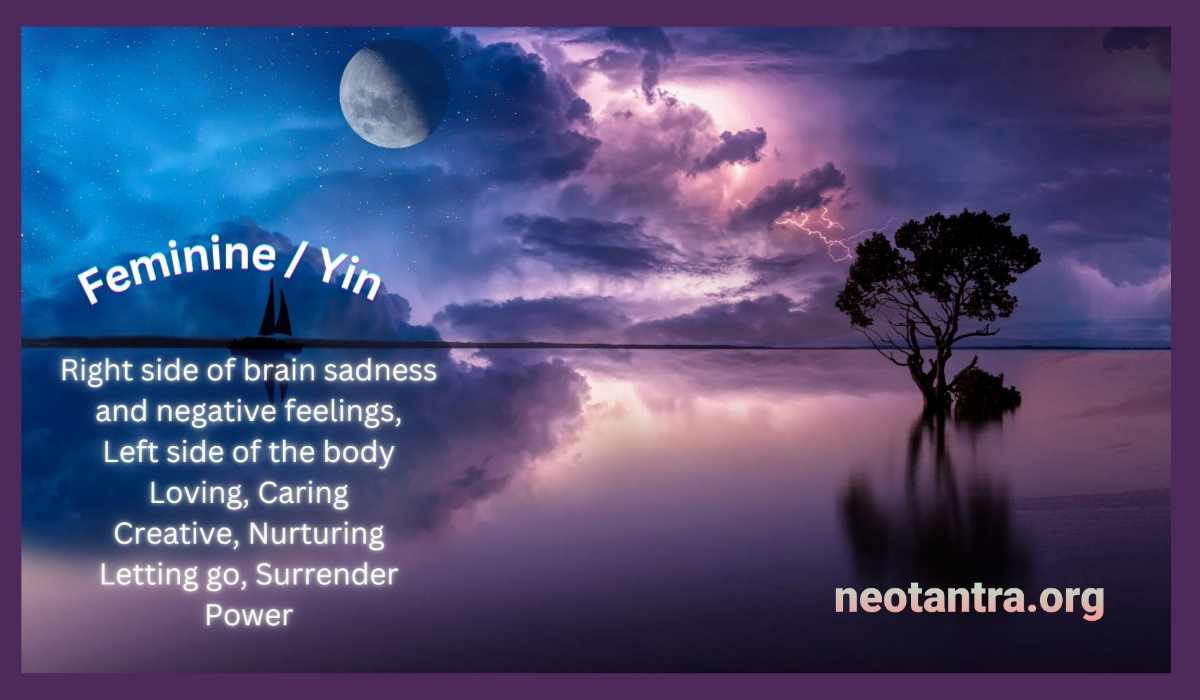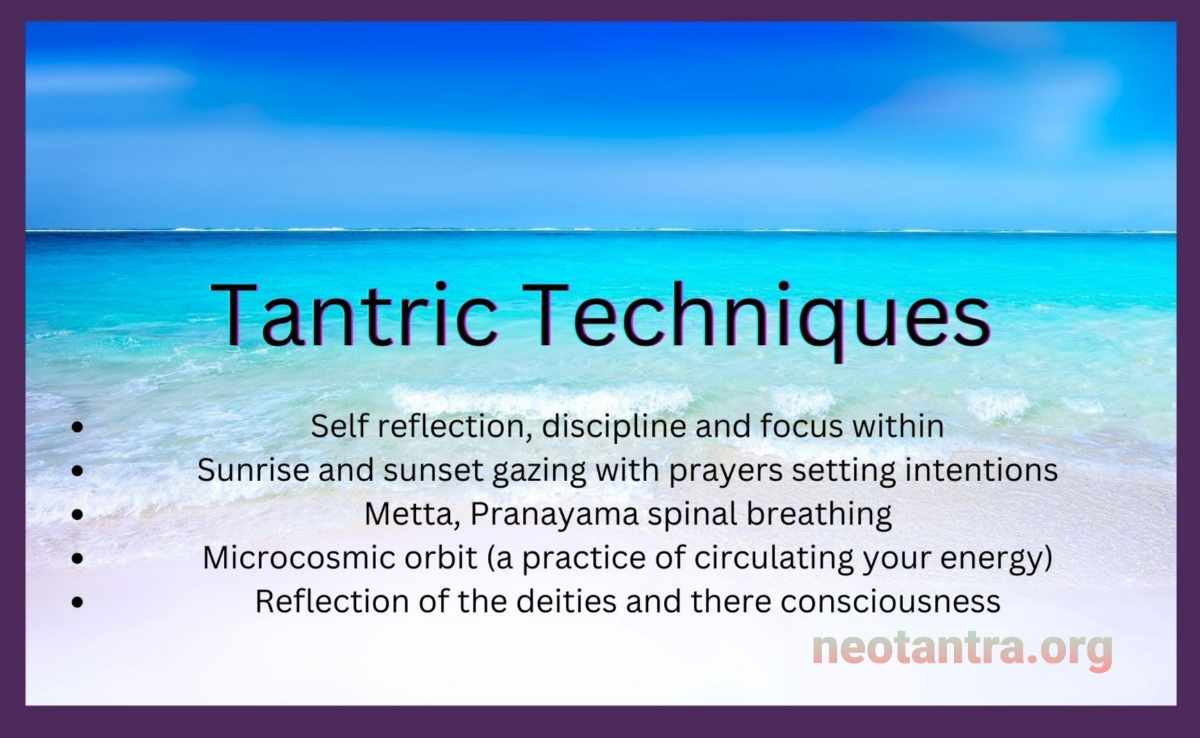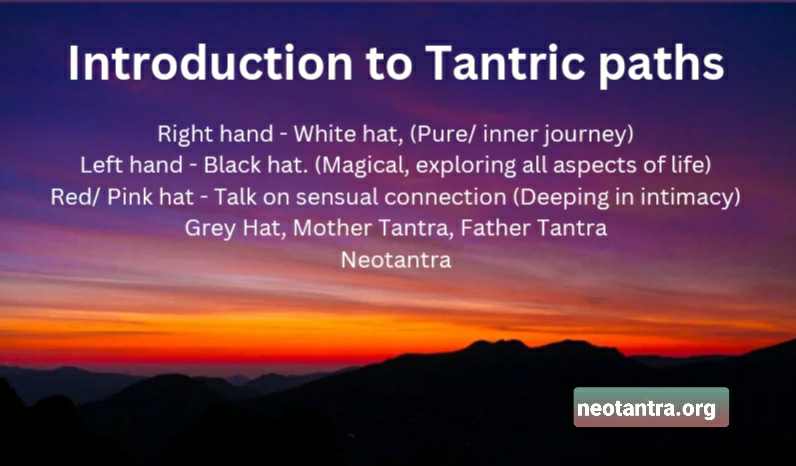Pink Tantra: to my understanding is a path of heart felt consciousness and connection. Celebration of sensuality in a wholesome expression and experience of the divine. Emphasising the cultivation of presence, love, compassion, respect, surrender and intimacy, often practiced in the context of romantic relationship with a trusted partner. 💖
Presented here are inspirational insights exploring the concept / phrase Pink hat Tantra, with the intention of deeping in the connection to the divine.
To show the different styles of Tantra, their are colours associated with each type of teachings. White Hat or white Tantra (pure/ inner journey) the right hand path, is the recommended starting point and the foundation of Tantra traditionally, where you practice meditation, purification, breathwork, yoga (Hatha, Kundalini, Kriya ect. ), to become liberated, with devotion to heart awareness to transcending ego – desire, attachment. Training the mind to with (Chanting, mantras, mandalas, spiritual studies ect.), and through the bodies awareness (Mudras, yoga, exploring senses) to get into deeper levels of awareness. Visualization techniques, as you advance embodying different deities wisdom and vibration. White Tantra or the right hand path is an inner journey, cultivating love, peace, surrender and presence.
From these foundations, if you felt the calling you could then explore the other forms of Tantra, expressed here through the colours.
The term “hat” is used to describe different practices, stages to enlightenment within Tibetan Buddhism. Eg. Six Yogas of Naropa Tantra.
On some occasions they would wear coloured hats during ceremonies. But generally its a conceptual idea.
The term pink hat is something different I believe, generalising Tantra into sub groups, exploring this later in article. This concept of colours I’ve found over time, talking with friends and at workshops, in videos and online.
Vajrayana sects of Tibetan Buddhism is one of the Tantric lineages. Hinduism is the other major source of traditional Tantra and influenced Buddhist Tantric teachings.
Different lineages within Buddhism have eg Yellow hat (Gelugpa lead by the Dalai Lama), black hat etc. Which is were the term Pink hat has possibly been inspired by.
To my understanding Pink hat Tantra is … ✨🌠🙏
- A heart based path of Tantra which is a blend between white hat and red hat where you focus on transcending lust (an energy of taking) to Love (an energy of giving). Raising (subliming) sexual energy into your heart. Exploration of your senses, touch, taste, making sound (fundamental to Deepening in intimacy), smell and eye gazing is a powerful practice to deepen this experience of oneness.
- Pink hat Tantra is a form of Tantra that is focused on cultivating love and intimacy in a relationship. This practice is centered around the idea that sexuality and spirituality are deeply interconnected, and that by embracing this connection, we can deepen our connection with our partner and access higher states of consciousness.
- Couples engage in practices and rituals that are designed to bring them closer together and enhance their intimacy. These may include eye gazing, breathing exercises, meditation, and physical touch, as well as more intimate practices such as massage and exploring the senses.This helps to create trust and openness between partners.
- Making requests is fun, but needs to be a big Yessssss or curiosity, taking things slowly is great. Highly recommend regularly body testing around any choices you have in any regard. One way is to think about something or feel into it and if the body leans forward its a yes and backwards is a no. Pendulum is another great tool, tarot cards eg. White Light Oracle, Enter the Luminous Heart of the Sacred, by Alana Fairchild is one of my favourites.
- Regulation of our nervous system is hugely important to deepen in any relationship, otherwise the mind can be looking for problems, when we calm down, and really come into our body it allows us to open and feel safe to explore sensual touch with yourself and partner, which brings deeper levels of intimacy.
- Creating sacred geometry together, understanding the wisdom of this ancient art and science of form and the interconnectedness of it all. With symbols like Vesica Pisces and the Merkabah, representing the balance and potential harmony between masculine and feminine energies. Here’s a link to more about the Basics of Sacred geometry.

- Negative and positive feelings are found on both sides of the brain research shows. These views in both images are metaphysical interpretations, possibilities…

- In Tantra, its commonly understood that we have masculine and feminine energies within, and that finding balance in both these aspects is important, specially in the brain hemispheres, achieved by meditation, crawling on all fours, juggling, poi, staff, pranayama and yoga nidra.
- One of the key principles of Pink hat Tantra is the idea that your sexual energy is a powerful force that can be harnessed for spiritual growth, transformation and bliss. By channeling this energy through the body and into the heart, couples can experience a deeper connection and ultimately unity consciousness.
- Pink Tantra is a sacred practice that can help couples explore their love and connection with each other, as well as themselves.
- Emphasizes the importance of love, respect, and clear authentic communication in the relationship. It encourages couples to embrace their vulnerable aspects with acceptance. To relate to each other with a respectful, mindful, and empowering energy to deepen their emotional bond with each other.
- One source says “pink hat” refers to the color of the hat traditionally worn by the female partner in Tantric practices, symbolizing the feminine energy of creation and nurturing.
In Pink hat Tantra, couples are encouraged to approach each other with a sense of curiosity, openness, and playfulness. This can include exploring intimacy, understanding each other and learning to communicate more effectively about their desires and boundaries. - In addition to physical practices, Pink Tantra also incorporates spiritual practices such as meditation, visualization, and chanting. These practices can help transcend the ego and for couples to access deeper levels of embodying the divine. Plus help to increase feelings of love, joy, and gratitude.
- Tantra originated in ancient India, and then Tibet and then Sri Lanka which created the roots of traditional Tantra.
- Another important aspect of Pink Tantra is the emphasis on mindfulness and presence. Partners are encouraged to be fully present with each other, focusing on the sensations and experiences in the present moment rather than getting lost in thoughts or distractions.
- A practice that can be adapted to suit the needs and preferences of couples. Some couples may choose to incorporate elements of traditional Tantra, such as the use of mantras or mudras, while others may prefer to focus on more modern practices such as mindfulness meditation or loving massage.
- Here are 50 questions to help develop a greater relationship.
- What do I most Deeply desire to receive from this / a relationship? What do I Yearn to be seen / recognised for in this relationship? What do I Long to offer into this relationship?
The concept of colored hats in Tantra is often associated with Tibetan Buddhism, specifically in the context of a practice known as “Six Yogas of Naropa” or “Six Yogas of Naropa Tantra.” In this practice, each hat represents a specific stage or aspect of the practitioner’s journey toward enlightenment. Here’s a brief overview of the colored hats and their associations:
1. White Hat (Vajra Yogini) Represents the first stage of the practice, which involves inner heat meditation (Tummo). The practitioner focuses on generating and controlling inner heat through specific breathing techniques and visualization practices.
2. Red Hat (Guru Yoga)
Symbolizes the second stage, which involves devotion and guru yoga practice. The practitioner cultivates a deep connection with their spiritual teacher (guru) and receives blessings and guidance from them.
3. Blue Hat (Illusory Body Yoga) Represents the third stage, where the practitioner focuses on developing the ability to dissolve the physical body and manifest an illusory body (Sambhogakaya). This stage involves advanced visualization and meditation practices.
4. Yellow Hat (Clear Light Yoga) Symbolizes the fourth stage, which involves experiencing the clear light of awareness (Dharmakaya). The practitioner learns to recognize and abide in the natural state of consciousness beyond conceptual elaboration.
5. Green Hat (Dream Yoga) Represents the fifth stage, where the practitioner learns to maintain awareness and lucidity during the dream state. This practice involves techniques for recognizing and working with the dream as a means of spiritual insight and transformation.
6. Black Hat (Bardo Yoga) Symbolizes the sixth stage, which involves navigating the intermediate state between death and rebirth (Bardo). The practitioner learns to recognize the signs of the bardo and navigate them skillfully to achieve liberation.
It’s important to note that the colored hats are symbolic representations of different stages of spiritual practice and are not literal headgear worn by practitioners. Each stage builds upon the previous one, leading the practitioner toward the ultimate goal of enlightenment.
Enlightenment, often associated with spiritual awakening or profound insight, can manifest in various ways, and different traditions and philosophies may emphasize different traits or qualities. Here are some traits commonly associated with enlightenment:
- Inner Peace
A deep sense of inner calm and tranquility, regardless of external circumstances. - Compassion and Empathy
A heightened sense of empathy and compassion towards all living beings, accompanied by a genuine desire to alleviate suffering. - Wisdom and Insight
Clarity of perception and profound understanding of the nature of reality, oneself, and others.
- Presence and Mindfulness
Being fully present in the moment, free from distraction or preoccupation with the past or future.
- Humility
A sense of humility and openness, recognizing the limitations of one’s knowledge and understanding. - Non-attachment
Freedom from clinging or attachment to material possessions, status, or outcomes, allowing for greater equanimity and detachment. - Detachment from Ego Transcending the ego or the sense of a separate self, leading to a dissolution of boundaries and a sense of interconnectedness with all of existence.
- Unconditional Love
Radiating love and compassion unconditionally, without expecting anything in return. - Gratitude
A deep sense of gratitude for life and all its experiences, both positive and challenging. - Simplicity
Embracing simplicity and living in harmony with nature and the natural order of things.
It’s important to note that enlightenment is often described as a journey rather than a destination, and these traits may be cultivated gradually over time through spiritual practice, self-inquiry, and inner exploration. Additionally, the expression of enlightenment can vary widely among individuals, as it is deeply personal and subjective.
Self-actualization involves transcending egoic desires and societal expectations to live in alignment with one’s true nature and potential. It’s a dynamic and evolving process that requires introspection, self-awareness, and courage to explore and express one’s unique gifts and passions. Self-actualized individuals often exhibit traits such as autonomy, spontaneity, creativity, and a deep appreciation for life’s experiences. They tend to have a strong sense of ethics and morality, guided by principles that prioritize the well-being of others and contribute to the greater good. Self-actualization is a continual journey of growth, discovery, and self-expression.
Lulu and Mischka, Rainbow Light, A beautiful song my dear friend Paul made the video, which embodies, I feel the natural essence of Tantra.
Tantra is a spiritual path that in particular lineages aims to awaken the dormant energy, or Kundalini, that lies at the base of the spine and to channel that energy upwards through the body’s seven chakras to achieve spiritual enlightenment.
64 arts and sciences of Tantra
Rose Tantra
Rose Tantra is a term that is sometimes used to refer to a particular form of Tantric practice that focuses on cultivating the qualities of love, devotion, and compassion as a means of spiritual transformation. In this practice, the divine is seen as both masculine and feminine, and the goal is to integrate these energies within oneself to achieve a state of wholeness and unity.
Rose Tantra can involve various practices such as meditation, visualization, mantra chanting, and ritualized ceremonies. Some practitioners may also incorporate the use of specific tools or symbols such as roses, crystals, or yantras (sacred geometric diagrams) into their practice.
The Kagyu Rose lineage
The “Rose lineage” is a term that has been used to describe a specific lineage within the Tibetan Buddhist tradition, which is known as the Kagyu lineage. The Kagyu lineage is one of the four major lineages of Tibetan Buddhism, and it is known for its emphasis on meditation and the use of direct experience to realize the nature of the mind.
Within the Kagyu lineage, the term “Rose lineage” has been used to refer to the teachings and practices of a specific master, Lama Tashi Namgyal a Tibetan master who was born in 1888 and spent much of his life in the Kham region of Eastern Tibet. He was a student of several important masters within the Kagyu lineage, and he was particularly known for his mastery of the practices of the Six Yogas of Naropa.
The teachings and practices of Lama Tashi Namgyal are said to have been passed down through a lineage of disciples, which is known as the “Rose lineage.” The Rose lineage is said to emphasize the practices of the Six Yogas of Naropa, as well as other advanced practices such as the Six Dharmas of Vajrayogini and the practice of Dream Yoga.
An example of Tantric lifestyle would be Anastasia the Ringing Cedars
Connection to Nature: Anastasia places a strong emphasis on the importance of connecting with nature and developing a deep relationship with the natural world. She believes that humans have strayed too far from their roots and that by reconnecting with nature, they can rediscover their true potential.
The Power of Thought: She teaches that thoughts have the power to shape reality and that humans have the ability to manifest their desires through focused thought. She also believes that our thoughts and emotions have a direct impact on the world around us.
Self-Sufficient Living: Promotes a lifestyle of self-sufficient living, where individuals are able to provide for themselves and their families through growing their own food, building their own homes, and relying on natural resources rather than modern technology and consumerism.
Cosmic and Spiritual Understanding: Anastasia possesses a deep understanding of the cosmos and the spiritual realm. She believes that humans are capable of transcending their physical bodies and connecting with higher realms of existence.
From an incredible book series called, Anastasia the Ringing Cedars
Some of the other forms include White Tantra (Right hand path), Grey (middle path), Red and Black (Left hand path)
White Tantra: Right hand path
Focuses on the purification of the body, mind, and soul through meditation, breath work, and yoga.
Emphasizes the importance of ethical behavior, including honesty, integrity, wisdom and compassion.
Subliming sexual energy into your heart. Transcending lust into love.
Often involves the guidance of a teacher or guru who has gone through a rigorous training process.
This type of Tantra is practiced with the intention of personal transformation and ethical conduct.
The white hat symbolizes purity and the inner journey. When it comes to personal growth and self-improvement, the white hat represents the process of self-exploration and introspection. It’s about looking inward and finding ways to become a better, more evolved version of oneself. This can include practices like meditation, mindfulness, therapy, and self-reflection.
The white Tantra is also associated with honesty and morality. It’s about living with integrity and doing the right thing, even when it’s difficult. The white hat represents a commitment to personal growth and living a life that aligns with one’s values and beliefs.
The white coloured clothing has been said to reflect energy, so a sensitive person doesn’t feel energies of others influences. Where black absorbs energy, is one point of view. You can also wear the colours of chakras you wish to embody. (Same as foods)
Eg. Kriya, Dakshina Marga, Samaya Marga and Kundalini yoga are all referred to as white hat or white Tantra.
Kriya Yoga Tantra:
This type of Tantra is associated with the teachings of Paramahansa Yogananda and emphasizes the use of kriyas (purification practices), pranayama (breathing exercises), and meditation to facilitate spiritual awakening and personal transformation.
Dakshina Marga Tantra:
This type of Tantra is associated with the use of external objects, such as sacred objects or images, to facilitate spiritual growth and personal transformation. Dakshina Marga Tantra incorporates practices such as the use of yantras (sacred diagrams), mantras (sacred sounds), and mudras (gestures) to connect with the divine
Samaya Marga Tantra:
Emphasizes the use of meditation, mantra chanting, and visualization to achieve spiritual awakening and personal transformation. Samaya Marga Tantra also incorporates the use of puja (worship) and other ritual practices to connect with the divine.
Kundalini Yoga Tantra:
This type of pure white Tantra which is associated with the awakening of the Kundalini energy, which is believed to lie dormant at the base of the spine, and emphasizes the use of meditation, pranayama (breathing exercises), and mantra chanting to facilitate the awakening of this energy. Kundalini Yoga Tantra also incorporates practices such as the use of mudras (hand gestures) and bandhas (energy locks) to support the awakening of the Kundalini energy.
Red Hat Tantra: left hand path
Emphasizes the use of sexual energy to achieve spiritual awakening.
May involve the use of sexual practices as a means of achieving enlightenment.
Often involves the use of taboo practices and rituals to challenge social norms and conventions.
May not place as much emphasis on ethical behavior and may not require the guidance of a teacher or guru.
This type of Tantra is associated with sensual and sexual exploration. Red Hat Tantra is often associated with practices such as black magic and love spells. This type of Tantra is generally considered unethical and not recommended for spiritual seekers.
Vama Marga Tantra
This left hand, red hat type of Tantra is associated with the use of sexual practices to facilitate spiritual awakening and personal transformation. Vama Marga Tantra incorporates practices such as maithuna (sexual union), mudras (gestures), and mantra chanting to awaken the Kundalini energy and connect with the divine.
Taoist Practices:
This type of Tantra is associated with Taoism and emphasizes the use of sexual practices to facilitate spiritual growth and personal transformation. Taoist Sexual Practices incorporate practices such as sexual meditation, breath control, and the cultivation of sexual energy to awaken the Kundalini energy and connect with the divine.
Grey Hat Tantra: middle path
This type of Tantra is practiced with both positive and negative intentions, depending on the practitioner’s goals and motivations. Grey Hat Tantra may involve practices such as using Tantra techniques for personal gain but may also incorporate ethical considerations and an intention for spiritual growth and personal transformation.
Black hat Tantra: Left hand path
The left-hand path of Tantra, embracing all aspects of consciousness, shadow work, acceptance of all life. A expansive journey, leaning into fear with a smile. Acceptance and experience of taboo practices. Not recommended as can easily lead to problems in general.
Jain Tantra:
This type of Tantra is associated with Jainism, an Indian religion that emphasizes non-violence, self-control, and the pursuit of spiritual liberation. Jain Tantra incorporates practices such as the study of sacred texts, meditation, and self-inquiry to achieve spiritual awakening and personal transformation.
🌅
Love to hear your thoughts?
What is most Inspiring?
Bless your heart!
Guy
Here’s a playlist for you
🌻🌌❤✨🔥





9 Comments
zoritoler imol
December 11, 2024Good post. I learn something more difficult on completely different blogs everyday. It should all the time be stimulating to learn content from different writers and follow a bit of one thing from their store. I’d desire to make use of some with the content on my blog whether or not you don’t mind. Natually I’ll provide you with a hyperlink on your net blog. Thanks for sharing.
tantra
February 23, 2025Absolutely, please share, thanks!!
tantra
February 23, 2025Sounds good @ thanks
Len Aherns
January 2, 2025Some really fantastic work on behalf of the owner of this web site, absolutely outstanding articles.
tantra
February 23, 2025Very kind of you! Thanks for your acknowledgement:))
tantra
February 23, 2025Really appreciate your feedback and acknowledge! Sure its a reflection of the person you are, always feel it’s in the eye of the beholder! Bless
zoritoler imol
March 29, 2025Glad to be one of the visitants on this awing web site : D.
tantra
March 30, 2025Thanks
tantra
March 31, 2025Thanks heaps
Leave A Response